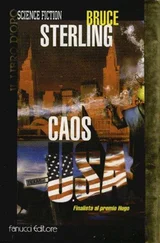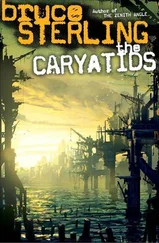Bruce Sterling - The Hacker Crackdown
Здесь есть возможность читать онлайн «Bruce Sterling - The Hacker Crackdown» весь текст электронной книги совершенно бесплатно (целиком полную версию без сокращений). В некоторых случаях можно слушать аудио, скачать через торрент в формате fb2 и присутствует краткое содержание. Жанр: Фантастика и фэнтези, на английском языке. Описание произведения, (предисловие) а так же отзывы посетителей доступны на портале библиотеки ЛибКат.
- Название:The Hacker Crackdown
- Автор:
- Жанр:
- Год:неизвестен
- ISBN:нет данных
- Рейтинг книги:4 / 5. Голосов: 1
-
Избранное:Добавить в избранное
- Отзывы:
-
Ваша оценка:
- 80
- 1
- 2
- 3
- 4
- 5
The Hacker Crackdown: краткое содержание, описание и аннотация
Предлагаем к чтению аннотацию, описание, краткое содержание или предисловие (зависит от того, что написал сам автор книги «The Hacker Crackdown»). Если вы не нашли необходимую информацию о книге — напишите в комментариях, мы постараемся отыскать её.
The Hacker Crackdown — читать онлайн бесплатно полную книгу (весь текст) целиком
Ниже представлен текст книги, разбитый по страницам. Система сохранения места последней прочитанной страницы, позволяет с удобством читать онлайн бесплатно книгу «The Hacker Crackdown», без необходимости каждый раз заново искать на чём Вы остановились. Поставьте закладку, и сможете в любой момент перейти на страницу, на которой закончили чтение.
Интервал:
Закладка:
In the meantime, we must continue our dogged pursuit of the E911 Document.
It must have been clear by January 1990 that the E911 Document, in the form *Phrack* had published it back in February 1989, had gone off at the speed of light in at least a hundred and fifty different directions. To attempt to put this electronic genie back in the bottle was flatly impossible.
And yet, the E911 Document was *still* stolen property, formally and legally speaking. Any electronic transference of this document, by anyone unauthorized to have it, could be interpreted as an act of wire fraud. Interstate transfer of stolen property, including electronic property, was a federal crime.
The Chicago Computer Fraud and Abuse Task Force had been assured that the E911 Document was worth a hefty sum of money. In fact, they had a precise estimate of its worth from BellSouth security personnel: $79,449. A sum of this scale seemed to warrant vigorous prosecution. Even if the damage could not be undone, at least this large sum offered a good legal pretext for stern punishment of the thieves. It seemed likely to impress judges and juries. And it could be used in court to mop up the Legion of Doom.
The Atlanta crowd was already in the bag, by the time the Chicago Task Force had gotten around to *Phrack.* But the Legion was a hydra-headed thing. In late 89, a brand-new Legion of Doom board, "Phoenix Project," had gone up in Austin, Texas. Phoenix Project was sysoped by no less a man than the Mentor himself, ably assisted by University of Texas student and hardened Doomster "Erik Bloodaxe."
As we have seen from his *Phrack* manifesto, the Mentor was a hacker zealot who regarded computer intrusion as something close to a moral duty. Phoenix Project was an ambitious effort, intended to revive the digital underground to what Mentor considered the full flower of the early 80s. The Phoenix board would also boldly bring elite hackers face-to-face with the telco "opposition." On "Phoenix," America's cleverest hackers would supposedly shame the telco squareheads out of their stick-in-the-mud attitudes, and perhaps convince them that the Legion of Doom elite were really an all-right crew. The premiere of "Phoenix Project" was heavily trumpeted by *Phrack,* and "Phoenix Project" carried a complete run of *Phrack* issues, including the E911 Document as *Phrack* had published it.
Phoenix Project was only one of many -- possibly hundreds -- of nodes and boards all over America that were in guilty possession of the E911 Document. But Phoenix was an outright, unashamed Legion of Doom board. Under Mentor's guidance, it was flaunting itself in the face of telco security personnel. Worse yet, it was actively trying to *win them over* as sympathizers for the digital underground elite. "Phoenix" had no cards or codes on it. Its hacker elite considered Phoenix at least technically legal. But Phoenix was a corrupting influence, where hacker anarchy was eating away like digital acid at the underbelly of corporate propriety.
The Chicago Computer Fraud and Abuse Task Force now prepared to descend upon Austin, Texas.
Oddly, not one but *two* trails of the Task Force's investigation led toward Austin. The city of Austin, like Atlanta, had made itself a bulwark of the Sunbelt's Information Age, with a strong university research presence, and a number of cutting-edge electronics companies, including Motorola, Dell, CompuAdd, IBM, Sematech and MCC.
Where computing machinery went, hackers generally followed. Austin boasted not only "Phoenix Project," currently LoD's most flagrant underground board, but a number of UNIX nodes.
One of these nodes was "Elephant," run by a UNIX consultant named Robert Izenberg. Izenberg, in search of a relaxed Southern lifestyle and a lowered cost-of-living, had recently migrated to Austin from New Jersey. In New Jersey, Izenberg had worked for an independent contracting company, programming UNIX code for AT&T itself. "Terminus" had been a frequent user on Izenberg's privately owned Elephant node.
Having interviewed Terminus and examined the records on Netsys, the Chicago Task Force were now convinced that they had discovered an underground gang of UNIX software pirates, who were demonstrably guilty of interstate trafficking in illicitly copied AT&T source code. Izenberg was swept into the dragnet around Terminus, the self-proclaimed ultimate UNIX hacker.
Izenberg, in Austin, had settled down into a UNIX job with a Texan branch of IBM. Izenberg was no longer working as a contractor for AT&T, but he had friends in New Jersey, and he still logged on to AT&T UNIX computers back in New Jersey, more or less whenever it pleased him. Izenberg's activities appeared highly suspicious to the Task Force. Izenberg might well be breaking into AT&T computers, swiping AT&T software, and passing it to Terminus and other possible confederates, through the UNIX node network. And this data was worth, not merely $79,499, but hundreds of thousands of dollars!
On February 21, 1990, Robert Izenberg arrived home from work at IBM to find that all the computers had mysteriously vanished from his Austin apartment. Naturally he assumed that he had been robbed. His "Elephant" node, his other machines, his notebooks, his disks, his tapes, all gone! However, nothing much else seemed disturbed -- the place had not been ransacked.
The puzzle becaming much stranger some five minutes later. Austin U. S. Secret Service Agent Al Soliz, accompanied by University of Texas campus-security officer Larry Coutorie and the ubiquitous Tim Foley, made their appearance at Izenberg's door. They were in plain clothes: slacks, polo shirts. They came in, and Tim Foley accused Izenberg of belonging to the Legion of Doom.
Izenberg told them that he had never heard of the "Legion of Doom." And what about a certain stolen E911 Document, that posed a direct threat to the police emergency lines? Izenberg claimed that he'd never heard of that, either.
His interrogators found this difficult to believe. Didn't he know Terminus?
Who?
They gave him Terminus's real name. Oh yes, said Izenberg. He knew *that* guy all right -- he was leading discussions on the Internet about AT&T computers, especially the AT&T 3B2.
AT&T had thrust this machine into the marketplace, but, like many of AT&T's ambitious attempts to enter the computing arena, the 3B2 project had something less than a glittering success. Izenberg himself had been a contractor for the division of AT&T that supported the 3B2. The entire division had been shut down.
Nowadays, the cheapest and quickest way to get help with this fractious piece of machinery was to join one of Terminus's discussion groups on the Internet, where friendly and knowledgeable hackers would help you for free. Naturally the remarks within this group were less than flattering about the Death Star.... was *that* the problem?
Foley told Izenberg that Terminus had been acquiring hot software through his, Izenberg's, machine.
Izenberg shrugged this off. A good eight megabytes of data flowed through his UUCP site every day. UUCP nodes spewed data like fire hoses. Elephant had been directly linked to Netsys -- not surprising, since Terminus was a 3B2 expert and Izenberg had been a 3B2 contractor. Izenberg was also linked to "attctc" and the University of Texas. Terminus was a well-known UNIX expert, and might have been up to all manner of hijinks on Elephant. Nothing Izenberg could do about that. That was physically impossible. Needle in a haystack.
In a four-hour grilling, Foley urged Izenberg to come clean and admit that he was in conspiracy with Terminus, and a member of the Legion of Doom.
Izenberg denied this. He was no weirdo teenage hacker -- he was thirty-two years old, and didn't even have a "handle." Izenberg was a former TV technician and electronics specialist who had drifted into UNIX consulting as a full-grown adult. Izenberg had never met Terminus, physically. He'd once bought a cheap high- speed modem from him, though.
Читать дальшеИнтервал:
Закладка:
Похожие книги на «The Hacker Crackdown»
Представляем Вашему вниманию похожие книги на «The Hacker Crackdown» списком для выбора. Мы отобрали схожую по названию и смыслу литературу в надежде предоставить читателям больше вариантов отыскать новые, интересные, ещё непрочитанные произведения.
Обсуждение, отзывы о книге «The Hacker Crackdown» и просто собственные мнения читателей. Оставьте ваши комментарии, напишите, что Вы думаете о произведении, его смысле или главных героях. Укажите что конкретно понравилось, а что нет, и почему Вы так считаете.



